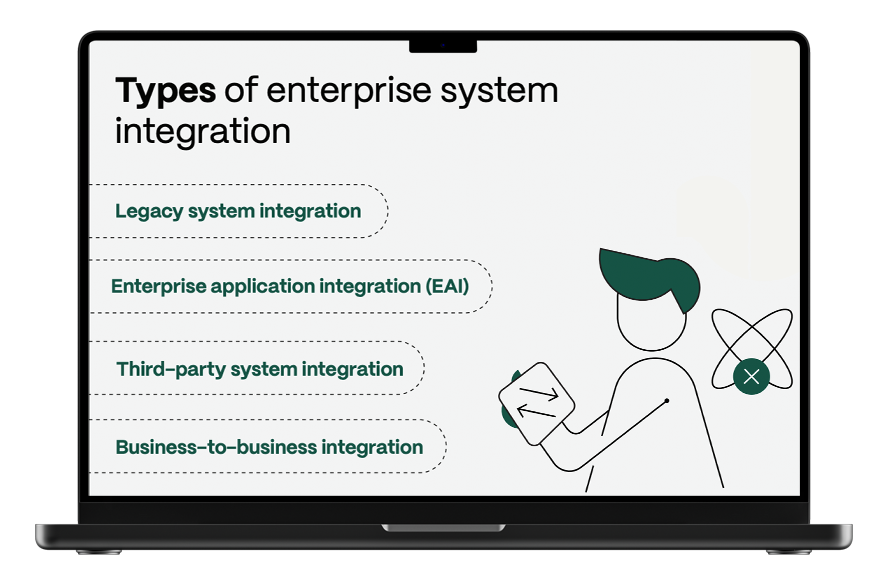Top 5 system integration challenges

System integration challenges can cause serious issues within an organization and create blockers for growth. If you strip any successful business to its core essence, you will find it’s driven by people who want to do their jobs well.
However, if they are frustrated or demoralized because they lack timely and accurate data, their routine work becomes laborious and inefficient. And that’s not a fruitful ground for innovation.
More often than not, business owners approach solving this problem from the wrong side. Instead of addressing the root cause (poorly integrated systems), they put a band-aid on it and employ extra people to tinker with Excel and data.
Things get a lot easier when you prepare in advance and stay aware of the main system integration challenges. These can be grouped into two buckets – one relates to the technical aspects of the system integration and the other is about user adoption and change management.
1. Connecting to legacy systems
Most enterprises have a monolithic legacy system that’s hard to replace. We’re talking about outdated technologies and communication protocols that are incompatible with modern systems. In most cases, they lack a well-defined API and have closely interdependent components.
In the context of this system integration challenge, limited documentation is a problem because you don’t know what you’re working with. This prevents you from fully understanding how the system works and what’s its intended behavior. You might incorrectly estimate what the system is capable of. The bottom line is that, without having a comprehensive single source of truth, you’re unable to successfully onboard new developers and properly maintain the system.
On top of everything, legacy systems typically use outdated security protocols and might not receive security patches as regularly.
Before integrating a new system with an old one, you must ensure that you understand how the legacy system is intended to be used and what integration points it provides. It would be wise to assess how difficult it would be to modernize the system before the integration and how to prevent it from negatively impacting the system it is being integrated with.
2. Change management on an organizational level
Even though legacy systems are far from ideal when it comes to efficient data flow, existing employees have been using them for years. They probably have established workflows and processes and found workarounds for everything that caused friction in their workday. When you invest an effort to make things work, you get used to the status quo, even if it’s not best for you.
Additionally, employees might fear the new system will jeopardize or replace their job positions. Just look at the rapid development of AI and all the controversy. Because the technology is so advanced and a lot of manual work is kicked out of the equation, people naturally worry about their job security. Similarly, system integrations might remove the need for manual copy-pasting or data management.
All employees must understand what are the benefits of the integration and how their jobs will be affected. It’s on leadership to clearly communicate this and properly support their subordinates. However, if there is a lack of leadership alignment, the issue gets a lot bigger and harder to manage.
In general, cultural inertia within the organization is one of the most commonly overlooked things that hinder progress–system integration decisions included.
3. The lack of resources and expertise
Large organizations recognize the value of system integration, but they want to cut corners and save money. There’s one important thing to remember here: if you think it's expensive to hire a professional to do the job, wait until you hire an amateur.
It’s vital to have experienced system integrators working with you because existing systems, integration technologies, and the overall architecture need to be properly analyzed. The success of the project depends on it. But what about budget constraints?
Budget constraints can lead to harmful compromises in the long run. When it comes to operational excellence and competitiveness, system integrations are usually not a “nice to have” but a “must have.”
The leadership team should have an open conversation and do an expert cost-benefit analysis to understand long-term savings, especially in the context of higher productivity rates and employee satisfaction. This is how the organization’s perspective gets shifted from “system integration is a cost” to “system integration is an investment.”
4. Data incompatibility
One of the main technical issues of system integration is data incompatibility. Imagine if you’d try to place a cube shape into a triangle. That won’t work, no matter how hard you try. Different systems might have different data types (e.g., integer, string, date), which means that data can get lost during integration or that interpretation errors emerge. Because of this, seamless data exchange is impossible.
When talking about data inconsistency, the antidote lies in robust data cleansing and thinking ahead to improve the reliability and usability of integrated data. Data governance policies will likely differ, which means that you need to reconcile them first. Once you do that, clear data validation protocols can help you avoid further problems. It’s about getting all key stakeholders on the same page (quite literally).
5. Ensuring scalability and security compliance
Integrated systems might rely on different technologies, platforms, and architectures. This means that a system integrator needs to take into account varying data volumes, processing capacities, and transaction rates. Predicting workloads to efficiently address fluctuating demands can also be challenging because the legacy system environment might be very different from a cloud-based environment of newly introduced systems.
You need an expert (or a team of experts) who understands the nature of both integrated systems and knows how to mitigate risks through various enterprise-specific security measures (e.g. access control, encryption, 2FA, and more). They would need to strategically approach interoperability challenges and security threats.
|
Want to learn more? Read our guide to system integration to make sure you have a futureproof plan moving forward. |
Eliminate system integration challenges before they appear
The best thing you can do to address system integration challenges? Be proactive and prepared. Solve them before they cause further issues down the line. We’ve seen many enterprises and large organizations go through these exact scenarios. This allowed us to learn from other executives’ missteps and to upgrade the playbook for successful system integration.
Set your people up for success. Don’t let legacy systems hinder your innovation. Get in touch with Vega IT today, we’re more than happy to hear from you.





